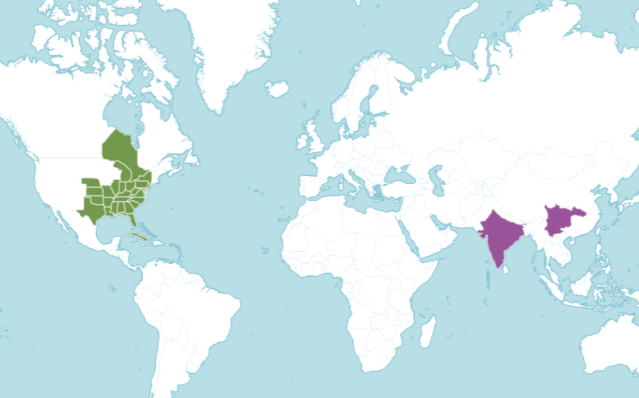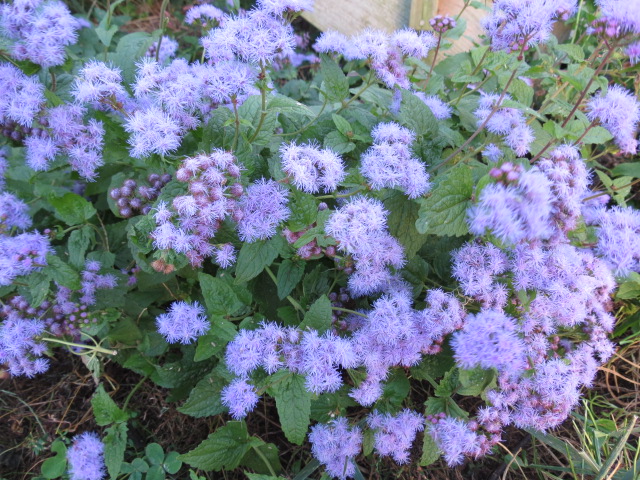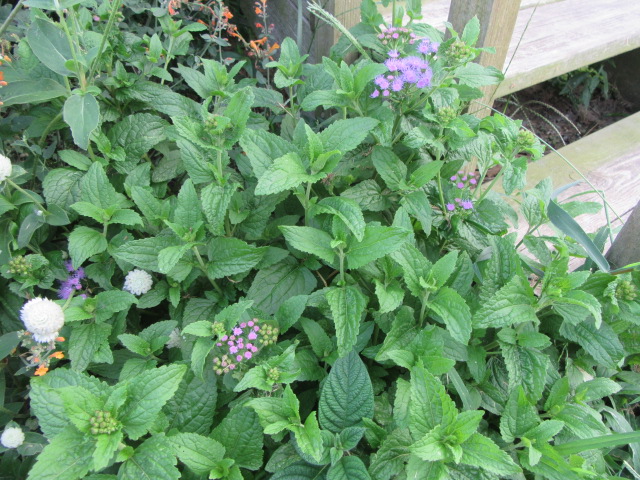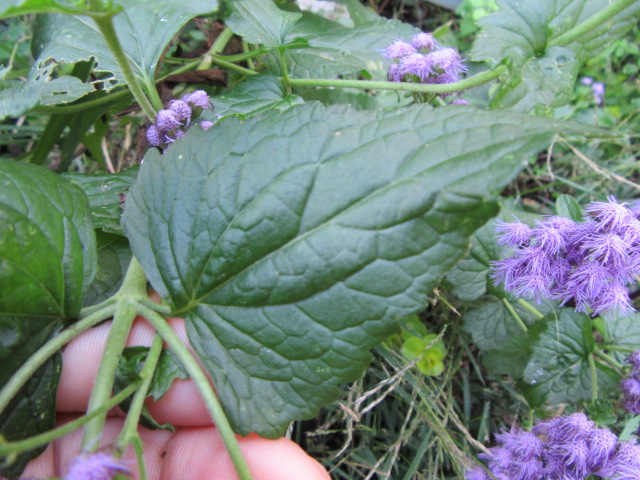
Conoclinium coelestinum (Blue Mist Flower) on 8-23-13, #178-48.
Blue Mistflower, Hardy Ageratum, Mist-Flower
Conoclinium coelestinum
koh-no-KLY-nee-um koh-el-ES-tee-num
Synonyms of Conoclinium coelestinum (8) (Updated on 11-30-23 from Plants of the World Online): Conoclinium flaccidum Greene, Conoclinium nepetifolium Greene, Eupatorium coelestinum L., Eupatorium coelestinum f. album Alexander, Eupatorium coelestinum f. illinoense Benke, Eupatorium deltifolium Raf. ex DC., Eupatorium deltoideum Steud., Eupatorium violaceum Raf.
Conoclinium coelestinum (L.) DC. is the accepted scientific name for the Blue Mistflower. Both the genus and species were named and described as such by Augustin Pyramus de Candolle in Prodromus Systematis Naturalis Regni Vegetabilis in 1836. It was FIRST described as Eupatorium coelestinum by Carl von Linnaeus in Species Plantarum in 1753.
As of 11-30-23 when this page was last updated, Plants of the World Online by Kew lists five species in the Conoclinium genus. It is a member of the plant family Asteraceae with 1,702 genera. Those numbers could change as updates are made on POWO. The genera in the family fluctuate quite often.

Distribution map of Conoclinium coelestinum from Plants of the World Online. Facilitated by the Royal Botanic Gardens, Kew. Published on the Internet; http://www.plantsoftheworldonline.org/. Retrieved on October 18, 2021.
The above distribution map for Conoclinium coelestinum is from Plants of the World Online. Areas in green are where the species is native and purple where it has been introduced. The map on the USDA Plants Database for North America above Mexico is the same.
The map on iNaturalist shows where members have made observations. Anyone can join and it is a great website to confirm and share your observations. The maps on iNaturalist are continually updated as members post new observations.
THERE ARE SEVERAL LINKS AT THE BOTTOM OF THE PAGE FOR FURTHER READING.

Conoclinium coelestinum (Blue Mistflower) on 8-23-13, #178-49.
My dad happened to get his start of this plant from Aunt Inez, his mother’s sister, who lived in Holden, Kansas many years ago. Good thing they still come up every spring. What I didn’t realize until recently is that the Conoclinium coelestinum is a native wildflower. SO, I had to update this page and add more information to reflect its wildflower status. This is definitely a species you don’t normally find while wildflower hunting and not one you see very often in flower beds. I am happy to have it, especially since the start came from my Aunt Inez.
Sometimes I name plants after where they came from. So, I called this plant Conoclinium coelestinum ‘Aunt Inez’ after my aunt for quite a while. I had to change that in case someone may think it is a cultivar name.
2013 was my first experience with this plant after moving back to the family farm in February 2013. They do pretty good here and return every spring. They came up better on the east side (left side) of the steps so I always have to transplant a few to the right side. They came up pretty good in the spring of 2013, even under the steps.
I didn’t take many photos in 2014 and none of the Conoclinum coelestinum.
<<<<2015>>>>

Conoclinium coelestinum (Blue Mistflower) on 4-21-15, #243-2.
They aren’t the first perennials to start coming up so you may have to be patient. The plants that grow from seed take even take a little longer. They mostly come up from seed unless we have a very mild winter.

Conoclinium coelestinum (Blue Mistflower) on 10-3-15, #272-14.
One thing is for sure, though, they will grow and put on an AWESOME show!
USEFUL INFORMATION:
FAMILY: Asteraceae
ORIGIN: Central and southwestern United States and the West Indies
ZONES: USDA Zones 5-10
SIZE: 18 to 36” x 18-36”
FLOWERS: Produces blue flowers from July through October
LIGHT: Full sun to part shade
WATER: Average water needs. Drought tolerant once established. They will grow in wet areas.
MAINTENANCE: As the plants get tall they have a tendency to flop and may need support.
USES: Beds, borders, attracts butterflies and other pollinating insects.
PROPAGATION: These plants spread by rhizomes, sometimes aggressively. They can easily be transplanted by digging the rhizomes in the spring. They also self-sow.
<<<<2016>>>>

Conoclinium coelestinum (Blue Mistflower) on 6-27-16, #270-21.
Once they start coming up pretty good, I always space them out a little more. Sometimes A LOT come up and sometimes not. Like I mentioned earlier, more come up on the east side of the steps and I always transplant some on the west side.

Conoclinium coelestinum (Blue Mistflower) on 7-19-16, #274-26.
In July they will start to flower and will soon be covered!

Conoclinium coelestinum (Blue Mistflower) on 9-3-16, #286-9.
Butterflies and other pollinating insects love the flowers. The butterfly in this photo is a Pearl Crescent (Phyciodes tharos).
<<<<2017>>>>

Conoclinium coelestinum (Blue Mistflower) on 5-26-17, #334-11.
The winter was pretty mild, so A LOT of the Conoclinium coelestinum came up in the spring of 2017. We always have a few Knotweed or Smartweed (whatever you choose to call them) that come up here, too. They are easily removed.

Conoclinium coelestinum (Blue Mistflower) on 6-24-17, #349-28.
They seemed to grow taller in 2017.

Conoclinium coelestinum (Blue Mistflower) on 8-7-17, #365-10.
They were just beginning to bud and flower when the above photo was taken on August 7, 2017.

Conoclinium coelestinum (Blue Mistflower) on 9-2-17, #370-6.
Sometimes we take the beauty of flowers for granted and fail to take a closer look.
<<<<2018>>>>
January 2018 was very cold and as of May 20 I had only seen one of these plants come up. It was also a dry spring which may also be one of the problems. Normally I cut the dead stems off and lay them over the area they grow in which allows their seeds to fall off there. But, last fall, I didn’t do that and didn’t cut them off until April. They had grown tall and flopped over in 2017, so maybe their seeds fell off in the grass during the winter.
If only one plant comes up, it will be difficult to get this plant to come back well. It may take some time.

Conoclinum coelestinum (Blue Mistflower) on 7-29-18, #487-32.
Several Conoclinum coelestinum finally came up on both sides of the steps.

Conoclinum coelestinum (Blue Mistflower) on 8-11-18, #494-2.
It was strange not having a mass of these plants on both sides of the steps in 2018 like there usually are.

Conoclinum coelestinum (Blue Mistflower) on 8-26-18.
The Conoclinum coelestinum looked really good with other plants like the Gomphrena globosa ‘Gnome White’.
I will have to do things a little differently this fall when I cut some of the perennials back. I will cut the Conoclinum coelestinum and lay the dead stems where I hope more will come up next spring.
<<<<2019>>>>

Conoclinum coelestinum (Blue Mistflower) on 6-9-19, #585-7.
Only a few Conoclinum coelestinum have come up in 2019. When you work in your flower beds earlier than some of the re-seeders emerge, sometimes they don’t come up well. That is what’s happening with these plants. The soil where these plants were growing was VERY HARD when I came here and I have been dealing with that. I have removed soil and added new soil and cow manure, etc. over the years but then I wind up with a sunk-in spot in the spring. It has been weird.
<<<<2021>>>>

Conoclinium coelestinum (Blue Mistflower) on 10-19-21, #847-1.
The Conoclinium coelestinum only came up on the right side of the steps in 2021. I am going to have to same seed and sprinkle them on the left side as well. Since only one or two plants came up I need to work on it… The stems get tall and they fall over so if the seeds fall into the grass they may not come up…

Conoclinium coelestinum (Blue Mistflower) on 10-19-21, #847-2.
I will write better descriptions of the leaves, stems, and flowers over the winter. I write descriptions for the wildflower’s pages, and since this species is a native, I need to treat it as such. There are several very good websites listed below if you need “technical” descriptions.

Conoclinium coelestinum (Blue Mistflower) on 10-19-21, #847-3.

Conoclinium coelestinum (Blue Mistflower) on 10-19-21, #847-4.

Conoclinium coelestinum (Blue Mistflower) on 10-19-21, #847-5.

Conoclinium coelestinum (Blue Mistflower) on 10-19-21, #847-6.
I think only one plant came up in 2022 and I hope more come up in 2023.
Overall, the Blue Mist Flower is a very good perennial to grow in a sunny area when it can get plenty of moisture when needed. I haven’t noticed any insect problems which is a plus. The grasshoppers don’t bother them even though we have plenty. This year, 2018, we had a terrible Japanese Beetle population that seemed to be everywhere. They ate the flowers of the roses but did not bother these plants.
There are two problems I have noticed, though. One is that if they are allowed to grow freely, they get tall then flop over and sprawl. This can be a problem if you have other plants in front of them. You can cut them back which will probably help, although I have not done this yet. The second problem is that sometimes they have an issue with powdery mildew. It doesn’t seem to harm the plants, but it just looks bad.
The other thing you have to consider is that they not only spread by rhizomes, they also self-sow. So, they don’t necessarily stay where you want them. The good thing is that the seeds don’t seem to go far. They come up under the steps and deck a little but not that bad. Just keep in mind, if they like where they are growing, they could become invasive. Just give them ample space to do as they please, and you will be pleased with them
I hope you enjoyed this page and maybe found it useful. If you have any comments, questions or suggestions, I would like to hear from you. Please click on “like” if you visited this page. It helps us bloggers stay motivated. 🙂 You can check out the links below for further reading. The links take you directly to the genus and species of this plant.
FOR FURTHER READING:
PLANTS OF THE WORLD ONLINE (GENUS/SPECIES
INTERNATIONAL PLANT NAMES INDEX (GENUS/SPECIES)
TROPICOS (GENUS/SPECIES)
FLORA OF MISSOURI (GENUS/SPECIES)
FLORA OF NORTH AMERICA (GENUS/SPECIES)
WORLD FLORA ONLINE (GENUS/SPECIES)
WIKIPEDIA (GENUS/SPECIES)
USDA PLANTS DATABASE
USDA PLANT FACT SHEET
MISSOURI PLANTS
MISSOURI BOTANICAL GARDEN
DAVE’S GARDEN
iNATURALIST
ILLINOIS WILDFLOWERS
FLORIDATA
NORTH CAROLINA STATE UNIVERSITY
WILDFLOWER SEARCH
KANSAS WILDFLOWERS AND GRASSES
LADY BIRD JOHNSON WILDFLOWER CENTER
MARYLAND BIODIVERSITY
FLORA FINDER
U.S. WILDFLOWERS
NOTE: The data (figures, maps, accepted names, etc.) may not match on these websites. It depends on when and how they make updates and when their sources make updates. Some websites have hundreds and even many thousands of species to keep up with. Accepted scientific names change periodically and it can be hard to keep with as well. Some of the links may use a name that is a synonym on other sites. In my opinion, Plants of the World Online by Kew is one of the most reliable and up-to-date plant databases and they make updates regularly. I make updates “at least” once a year and when I write new pages or add new photos but I do get behind. We are all a work in progress. 🙂
I just bought some Blue Mist Flower and googled it and found your blog post on that subject. I really enjoyed your photos and writing about it “gardener to gardener” – so much more informative than reading about it on a nursery site that sells them.
I tried to hit the “like button” but could not remember various passwords for WordPress, etc.
LikeLiked by 1 person
Hello Sue! I am glad you purchased some Blue Mist Flowers and I hope you enjoy them. They are indeed delightful. I know what you mean about the “like” button and having to log in and everything. It is easier if you log in to WordPress, if you have a blog, and follow through the reader. I am glad to hear from you and hope the best for you and your new Blue Mist Flowers. Hope to hear from you again and thanks for the comment!
LikeLike
I bought this plant two years ago from Bluestone Perennials. The first year it stayed small and had beautiful blue flowers that bloomed around the same time as my Solidago Fireworks Goldenrod. The second year it doubled in width and height. I was shocked at how tall it grew – so I agree with you, this year I plan on pinching it back like I do with mums, or possibly cutting it in half. The blue flowers are beautiful and it’s a carefree plant.
LikeLiked by 1 person
Hello Tia! Conoclinum coelestinum can indeed get a bit carried away. Last season there were just a few plants remaining for some reason. I hope cutting yours back helps to control the height and maintains a bushier growth. Wishing you continued success! Thanks for the comment!
LikeLike